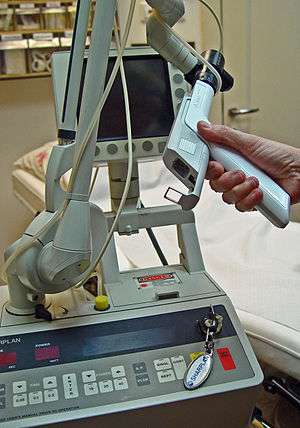Soft-tissue laser surgery

In soft-tissue laser surgery, a highly focused laser beam vaporizes the soft tissue with the high water content. The laser makes small incisions when the beam is focused on the tissue: the focal spot size can be as small as 100 µm, but the most widely used in practice is 400 µm (0.4 mm).[1] When the beam is defocused, the intensity of the laser light on the tissue diminishes, and it can be used for cauterization of small blood vessels and lymphatics, therefore decreases post-operative swelling.[2]
Surgical applications
Soft-tissue laser surgery is used in a variety of applications in human (general surgery, neurosurgery, ENT, dentistry,and oral and maxillofacial surgery[3]) as well as veterinary [2][4] surgical fields.
A laser beam has a natural sterilization effect: it evaporates bacteria, viruses and fungi, which leads to a decrease in local infections. Probably most important, the laser decreases post-operative pain by sealing nerve endings.
Soft-tissue laser surgery is differentiated from hard-tissue laser surgery (bones and teeth in dentistry [5]) and laser eye surgery (eyesight corrective surgeries [6]) by the type of lasers used in a particular type of laser surgery.
Lasers
Hard tissue surgical lasers are dominated by Er:YAG lasers operating at the wavelengths of 2.94 µm. Laser eye surgery utilizes excimer lasers in the UV range of wavelengths. Unlike many solid-state and diode lasers in the visible and near infrared wavelength range (600-2,000 nm), the carbon dioxide laser wavelength (10.6 µm) is highly absorbed by in-vivo soft tissues containing water.[7] Furthermore, modern CO2 laser technology makes these lasers far more affordable than solid-state Er:YAG lasers, which also feature a wavelength that is highly absorbed by water. Because of their wavelength and precision, CO2 lasers remain the dominant soft-tissue surgical lasers.[1]
The CO2 laser remains the best surgical laser for the soft tissue where both cutting and hemostasis is achieved photo-thermally (radiantly).[1][8][9]
Surgical laser systems are differentiated not only by the wavelength, but also by the light delivery system: flexible fiber or articulated arm, as well as by other factors.
Minimally invasive interaction of ultrashort pulse lasers with biological tissues has been investigated to understand their characteristics and mechanism and how they can be utilized to advance surgical applications of lasers.[10]
See also
References
- 1 2 3 "Soft Tissue Laser Surgery". LightScalpel.
- 1 2 https://aesculight.com/state-of-art-laser-surgery.php Veterinary laser surgery, URL accessed March 25, 2008
- ↑ Andreas Moritz (2006). Oral Laser Application. Quintessence Publishing Company, Incorporated. ISBN 978-1-85097-150-4.
- ↑ Noel A. Berger; Peter H. Eeg (9 January 2008). Veterinary Laser Surgery: A Practical Guide. John Wiley & Sons. ISBN 978-0-470-34412-5.
- ↑ Donald J. Coluzzi; Robert A. Convissar (2007). Atlas of Laser Applications in Dentistry. Quintessence Publishing Company. ISBN 978-0-86715-476-4.
- ↑ http://www.fda.gov/cdrh/lasik/ URL accessed March 25, 2008
- ↑ http://www.lsbu.ac.uk/water/vibrat.html Water Absorption Spectrum. URL accessed April 3, 2008
- ↑ Vogel, A; Venugopalan, V (2003). "Mechanisms of pulsed laser ablation of biological tissues". Chem Rev. 103 (2): 577–644.
- ↑ Levine, R; Vitruk, P (2015). "Laser-Assisted Operculectomy". Compend Contin Educ Dent. 36 (8): 561–7. PMID 26355439.
- ↑ Sajjadi, Amir Yousef; Mitra, Kunal; Guo, Zhixiong (2013). "THERMAL ANALYSIS AND EXPERIMENTS OF LASER–TISSUE INTERACTIONS: A REVIEW". Heat Transfer Research. 44 (3-4): 345–388. doi:10.1615/HeatTransRes.2012006425. ISSN 1064-2285.